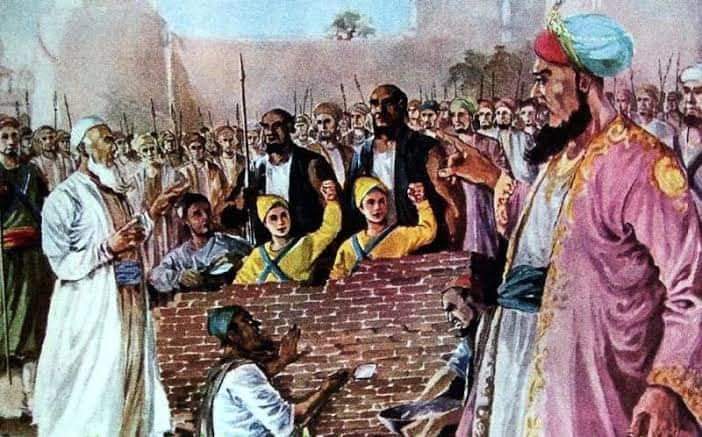
वीर बाल दिवस - Happy Children's Day! This day (26 Dec) in 1705, Zoravar Singh, aged 9 and Fateh Singh, aged 6 (younger sons of Guru Govind Singh, 10th Sikh Guru) were buried alive into a wall under orders of Mughal Governor Wazir Khan.
A tribute to the brave sons of Bharat Mata who attained martyrdom for Dharma and the motherland.
Guru Gobind Singh fought many battles against Mughals. His two elder sons Ajit Singh and Jujhar Singh attained martyrdom in battlefield fighting against Aurangzeb's Mughal forces in the Battle of Chamkaur. The Sikhs won this battle.
The Mughals including Aurangzeb were known to break promises. In 1705, Mughals under orders of Aurangzeb laid siege of Anandpur Sahib. The Sikhs offered resistance until the stock of food ran out.
Mughals promised that if the Anandpur Sahib fortress was handed over to them, they would not harm the Sikhs and the Guru and his family. Guru Gobind Singh agreed.
The Guru and his family and a small group of Sikhs had not gone far when the Mughals started chasing them, thus breaking their promise. Part of this story is described in Chapter 9 in Book 2 of #SaffronSwords
Guru Gobind Singh entrusted his cook Gangu to take care of Mata Gujri, his mother and his two younger sons Zorawar Singh and Fateh Singh.There had been traitors who, for the sake of money, had put the motherland at stake and facilitated enemies to harm their own fellow countrymen
There is no dearth of traitors today too. Gangu, bribed by the Mughals, did not keep the words of his Guru. He facilitated the Mughals under Wazir Khan (Nawab of Sirhind) to capture them.
Wazir Khan was brutal to the young sons of Guru Gobind Singh. He agreed to spare their lives if they converted to Izlam. Zoravar Singh and Fateh Singh did not agree and stood up for Dharma till their last breath. They were then buried alive.
Not many of us know about many of the young warriors of our soil. It is time our history textbooks feature them for current and future generations to draw inspiration.
Vande Mataram!


Vande Mataram!



• • •
Missing some Tweet in this thread? You can try to
force a refresh





